Understanding PLANETARY GEAR set !

(c) Lesics The planetary gear set, also known as the epicyclic gear train, is one of the most important and interesting inventions in …
1:23 “that is an impossible condition” It is very much possible, very well documented and often fun to watch from a distance. you may carry on.
I learned this more easily when I was 12 years old by reading a series of carefully written car books, produced in 1957 and offered for free by GM. Specifically – “Power Goes To Work (In the Automobile)” and revised in 1969. And it does help to be in a calm state of mind. Ha ha.
You guys are doing very great jobAll animation videos are very good. I am assistant professor in mechanical engineering . I used to show my students. I hope you guys will make such knowledgeable videos related to mechanical engineering. Thanks you
Se ve exelente así es gran funcionamiento interior de el diferencial 👍
Great vid! I wish you had one specifically for the Borg warner overdrive, that used the same setup to simply add a gear to a manual transmission and at the same time make it automatic!
Just found your channel, wish I had this when I was an undergrad hahha thank you for the wonderful content!!!!
Alright got it, good video. Now what I really want to know about is an interplanetary gear set!
You could make an equal wheel spin differential with 2 of these. Awsome!
Thanks. I was not able to grasp things clearly while reading the book but this video made concepts clear 👍
It was so helpful! Keep up the good work!
you guys are just awesome.. thanks for the best engineering videos
The best explanation with all fundamental concepts . Just loved your work @LearnEngineering .Love u
Outstanding I’m in love with this Planetary Gear stuff…I find it very intriguin, facsinating
Amazing. Thanks for the clever engineers.
I have cleared BE in 2017 and understood this concept in 2021 😝😝😝. God bless you Sir. Make more and more videos Sir.
@LearnEngineering what software do you use to model such mechanisms? Can it be done in Fusion 360?
Whoever invented this deserves a cake. Genius.
Speed reducing or torque multiplier gear boxes play important role in machineries… please do make some videos on that…(worm,helical,spur,drum drive) if possible calculation too..
Sir, can you please tell me which software did you use to design these animations.Your videos are awesome.
Awesome Explanation 👌I understand very well 👩🔧Thankyou So Much Sir 🙆💕
How does a Transformer work ?
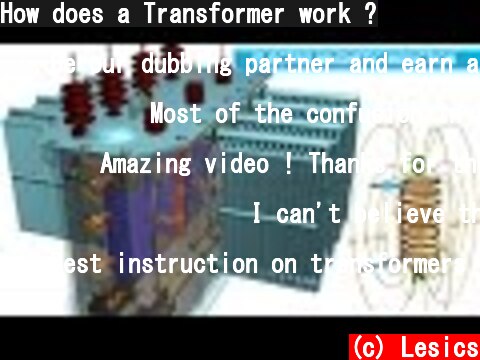
(c) Lesics Help us to make future videos for you. Make LE’s efforts sustainable. Please support us at Patreon.com …
Be our dubbing partner and earn a regular income !http://www.learnengineering.org/p/be-our-dubbing-partner.html
Most of the confusion in a student’s mind is caused by bad teachers who do not know the basics themselves.Thank you for doing a great job.
Amazing video ! Thanks for the upload ! 😀
I can’t believe this is for free. Thank you so much. As a graduate electrical engineer I have been desperate to see how a transformer is actually constructed in real life. This was perfect for me. You rock!
Best instruction on transformers I’ve ever had. Outstanding graphics.
Actually the high voltage side is usually in a delta configuration and the low voltage side is in star configuration. The delta configuration allows us to transport power without the use of a neutral, saves some money. And the star configuration is needed for a ground reference, otherwise the consumers do not have a voltage potential difference.
Excellent work! Open and accessible knowledge like this, is the way to go for a better society. Thank you for sharing!
Excelente legenda, parab�ns para quem fez! Thank you for translation to portuguese!
You guys(Lesics) are awesome! your animations are way helpful than you can even imagine! we are grateful for your effort!
Very clear informations! I’m graduated at civil engineering, but have been learning about mechanics, electricity and electronic with your videos. Thank you for the excellent material!
I’m still confused. How exactly do they turn into cars?
Excelente explica��o. Parab�ns!
Found out this channel accidentally and I love it. I love simple step-by-step explanations and the actual models – makes everything so simple and clear. Keep it up!
Another helpful video for my physics class! It’s so much better for me when I can visualize concepts and things like transformers.
Awesome, very informative! I love that it explained exactly what happens at the atomic level.
Outstanding work with really good illustrations. Thank you for this !
for those whom it might help click in their heads: The magnetic field created by the coils travels through the iron core in order to reach the secondary coil.
Great video, very clear and concise. Just a couple of questions. Is there a loss in amperage when a voltage is increased or an increase in amperage when voltage is lowered? If so, is it significant (say when 13.8 kv is increased to 765 kv)? Also, the inner winding seems to be very close to the outer winding. How do they not arc to each other?
Absolutely great video. Nice explanation of 3-phase. Incredible graphics, too Thanks!!
Sir, could you please make a short simple video on dot convention animation for transformer and/or magnetically coupled coil. I am bit confused with that subject matter. That will help many of us to understand the very basic concept of dot convention through illustration. Thank you in advance.
How does a Helicopter fly ?
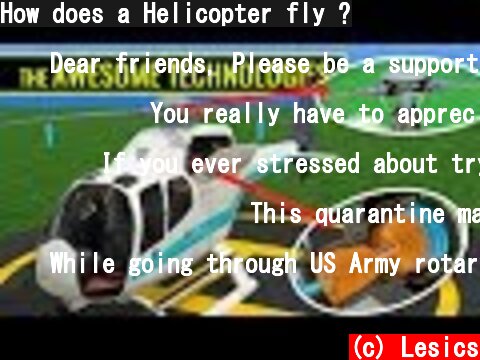
(c) Lesics Please support us at Patreon.com so that we can add one more member to the team and will be able to release 2 educational …
Dear friends, Please be a supporter of LearnEngineering. We can provide you more awesome contents in the future. https://www.patreon.com/LearnEngineering
You really have to appreciate the genius of the people who invented the helicopter. In a way, they are more fascinating than planes.
If you ever stressed about trying to please everyone remember over 2000 people disliked a video that explains how helicopters work
This quarantine made me learn a lot of things . From autopsy to aeronautics
While going through US Army rotary wing flight school in the early 90’s my instructor pilot said helicopter pilots fly by constantly correcting for mistakes they just made. Difficult at first but an absolute blast to fly (OH-58 and UH-1’s)
It’s incredible! There are years I tried to understand some things explained here, and these are told in a very simple way. Congratulations, great job ☺
This explains why the RC Helicopter mission in GTA Vice City was such a pain in the ass
Phew! Never thought helicopters were this complicated. Brilliant animation and contemporary topics covered. Keep it up.
this is absolutely amazing, the design and mechanical complexity. crazy what we humans can do.
Thank you for this most informative video, really well produced & presented. Amazing how complex these machines are, fascinating design in the angles of the blades & manoeuvrablity. The amount of revolutions must lead to so much necessary maintenance.
Incredibly complicated engineering, had to watch a few times to fully understand everything going on. It’s truly amazing.
This is amazing. Thank you so much for this. Incredibly elegant and effective explanation. Love it!
Another factor to be taken into consideration when moving from the hover and transitioning to forward flight is the relative speed of the blade moving forward (the advancing blade) in the same direction as the helicopter and the blade on the opposite side of the rotor disc that is moving backwards (the retreating blade). Lift is generated by the shape of the aerofoil, the area of the aerofoil surface, the angle of attack and the speed through the air. In forward flight the advancing blade has its speed added to the forward speed of the aircraft and the retreating blade has its speed subtracted. Unless corrected, this would cause the helicopter to roll over as far more lift would be produced on one side of the disc compared with the opposite side. This is controlled at the rotor mast head by allowing the advancing blade to move backwards slightly relative to the rotor disc spin and the retreating blade to move forwards. Thus less lift is produced on the advancing blade, more lift is produced on the retreating blade which evens out the lift on both sides. This adjustable movement is controlled at the blade root.
Now I understand why learning to fly a helicopter was so hard in San Andreas.
Thanks, great graphics & clear explanation. I’m guessing a lot of test pilots died developing the helicopter!
This man literally wants to make me scientist …my curiosity is increasing day by day 😂😂
What a great work done by engineers.Your videos are consistently outstanding,
Beautifully explained. Amazing job guys!
The mechanism of the swash plate is so ingenious and elegant, i almoust cry looking at this video! BTW thanks for such a great content!!!
Oh man, I have seen several other videos explaining the mechanics, I clicked on this thought maybe this one finally makes me understand completely and yes! At 3:58 I am absolutely in the picture and finally, understand what makes the blades doing the job and how it is connected to the control stick. It is pretty easy at the end 🙂 I always thought what the magic is behind the rods and all the stuff at the rotor 🙂
How do Wind Turbines work ?
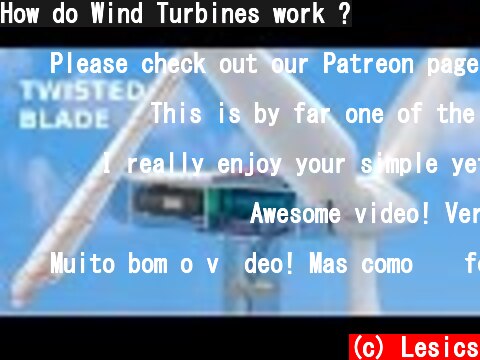
(c) Lesics Help us to make future videos for you. Make LE’s efforts sustainable. Please support us at Patreon.com …
Please check out our Patreon page https://www.patreon.com/LearnEngineering and extend your support.
This is by far one of the most interesting project collab by civil, electrical and mechanical engineers
I really enjoy your simple yet comprehensive explanations and amazing animations. Thanks!
Awesome video! Very well done, good pacing and strong animations
Muito bom o v�deo! Mas como � feito o controle para que o gerador gere energia a uma frequ�ncia constante?
Very interesting, I was asking myself the other day how they worked and this is a great explanation video.
great video! As someone who builds these for a living I like that you got all the terminology correct. One of the biggest things I’ve noticed when I tell people what I do is that there are ONLY two types..you either think the turbines are “cool” or you find some reason to hate on them. Solar, wind, and battery technologies are the future..people can talk crap about my industry but if I had the choice of raising a kid next to a wind farm, or a toxin belching coal power plant..the choice is real obvious right?
Thank you for making things .Easy .Straight forward and to the point
Great insight into the build just subscribed and it’s a nice compact turbine I also have built a homemade 650 watts wind turbine, a treadmill motor turbine and a little but powerful ametek 30v turbine and built 2 diy solar panels, be careful in high winds one of my first turbines blew up 😕and now have only 2 wonderful turbines working daily 😊it’s very satisfying watching those things working, keep up the good work buddy 👍
Thank You! Finally a common sense explanation. I think long term they will generate DC and house long lasting batteries. With the changeover of ICE vehicles to electric one wonders if it would make sense to have a DC power reticulation to avoid skin effect losses.
The wind passes over the blades and makes them turn (kinetic energy) the blades turn a shaft within the nacelle(the box at the top of the turbine).The shaft turns a generator which converts the kinetic energy into electical energy. A step up transformer converts the electricity to a higher voltage to be transmited (electrical transmission) ; Typically to 11,000V up to 33,000V and The electricity is then exported to the local electricity grid network.
Great Video, putting things together expertly! Any idea how it matches or tracks grid frequency of 50/60 Hz?
Great Video, putting things together expertly! Any idea how it matches or tracks grid frequency of 50/60 Hz?
Great video, most of the videos I’ve seen, focus only on explaining the pitch angle control of blades, leaving beside the explanation of orientation angle control, it’s nice to watch a video that also explains this.
Lived around these for years and knew really nothing about them till this video. Thanks! Excellent animation, well done; using animation for education rather than mind control…..BRAVO!
I’ve always wondered why they moved so slow but yea I can now see that they’re more advanced than I thought. Thanks
A simple, yet excellent description of wind turbine operation; I was particularly impressed with the description of how the efficiency was naturally limited due to the need for wind to exit the blades.I really would have liked some information, however, on how phasing of the collective outputs of the turbines is achieved, and perhaps this may be included in a later tutorial? My thanks to you for posting the tutorial.
Great video. I’ve studied wind turbines and designed an airfoil, but I had forgotten many of these points since then…especially Betz limit.
Finally! I understood, why the Blades are twisted and not exactly parallel to the wind stream. Thanks a lot!
Love the way wind turbines work and produce green clean energy💚
Tesla Turbine | The interesting physics behind it
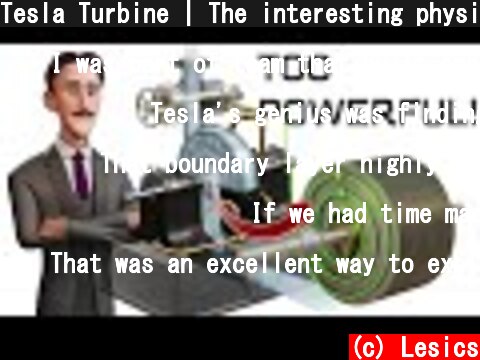
(c) Lesics The maverick engineer Nikola Tesla made his contribution in the mechanical engineering field too. Look at one of his favorite …
I was part of team that built one of these for an Airforce design competition in college. We could reliably get ~94% efficiency with a closed loop superheated steam system harvesting exhaust heat from a small jet engine and got just below 96% efficiency in some ideal test cases. The main limiting factors were that the discs had to be designed to stretch uniformly without distorting at ~40k RPM and that the gaps between the disks had to be designed for an incredibly specific set of operating parameters (steam temp, pressure, velocity, etc.). The smallest variations, or while waiting for it to spin up, and we wouldn’t even get close to those efficiencies. A lot of the initial designs weren’t efficient enough to reach the right parameters at all.
Tesla’s genius was finding solutions to problems. By doing so, he also created a few problems which, therefore, made him even more inventive.
That boundary layer highly depends on the fluid being used. Tesla’s design was based on water. There are many fluids that have very low cohesion like castor oil, but water has a unique property of high cohesion. Surely PTFE should suck for boundary layer. So, adhesion levels would be between the material of the disk and the fluid. Some kind of anodic fluid to metal substrate might be best, but wear out. It would be interesting to see more videos about titanium disks with some kind of cobalt substrate and cupric fluid for more magnetic type cohesion and adhesion. Anyway, the design is so simple, but has potential that people just left on the design floor. Crazy.
If we had time machines, I would love to use one to bring Tesla to the future so he could continue his experiments with new tech. Man was a legend of his time and I bet if he lived today he would make something even greater.
That was an excellent way to explain boundary layer theory in a simple manner! The rest of the video is also great.
Poor Nikola, he was born a few centuries ahead of time. He’s one of the most misunderstood geniuses
I like how the RPM of the 3 meter disk was assumed and not the fluid flow velocity. Since the turbine works on skin friction, the average speed of the disk cannot exceed the average speed of the fluid. At the tips, if the disk is spinning faster than the fluid, then the fluid will actually be slowing it down rater than speeding it up. You could have just said that you would need the fluid to flow at Mach 18 to spin the disk fast enough, and that’s assuming the material could handle the centripetal forces, which they can’t. There’s no way we are making a hypersonic fluid flow contained in a pipe in the first place, regardless of if the disk could handle the forces. It’s a non starter on multiple fronts.
Amazing, I can only wonder how magnificent it is when advanced engineers have conversations and brainstorm new ideas
TESLA : “It seems that I have always been ahead of my time. I had to wait nineteen years before Niagara was harnessed by my system, fifteen years before the basic inventions for wireless which I gave to the world in 1893 were applied universally.”we have to wait more for Tesla Turbine because we dont have strong enough material this monster 🙂
Very interesting tech. I’m glad it can be used under different scale projects.
Great video! There is another basic turbine configuration that wasn’t mentioned. That is the API 611 solid wheel steam turbine which is commonly used in the petroleum industry. The design uses buckets machined into the outside of the wheel which enhance the power transmission capability of the drive over a straight up Tesla design. The advantage of the solid wheel API 611 turbine over conventional axial flow bladed turbines (which are more efficient) is that the solid wheel design can handle liquid slugs which are often present due to poor quality steam that falls below superheated temperatures as it is pumped to the turbine. It is hard to keep pressurized steam in the superheated state when transported from the boiler to the turbine.
Well made examples of something a good few people could make themselves, thanks for posting
I thought by changing between the plates would work. But on second thought I think by damping the exhaust’s, the one could control the heat in the boiler and control the speed of the turbine.
Man really said”I’m limited by the technology of my time”
I wonder if there has been research into higher viscosity, slower rpm applications. I’m curious about how much torque could be achieved. I expect it’s quite low, but what’s the upper limit?
Excellent video!Incredibly well explained and detailed.Congrats 😉 and huge thanks for making and sharing 🙂
Something even more incredible that was illustrated in this video but not talked about is the “Tesla Valve”. This man was an absolute genius.
Проблема турбины Тесла,как и турбины Лаваля это преобразование высоких оборотов в приемлемые 1500-2000об.мин.Редуктора больше турбин в 3 ,4 раза.При таких оборотах сильно повышается требование к деталям,центробежная сила измеряется в тоннах.Турбины Лаваля развивали до 30 000 оборотов и лоптки при отрыве пробивали чугунные корпуса.Да это можно использовать,но с другими материалами.
You had explained the boundary layer concept so easily my professors can’t even get near.
Could we reduce the required RPM by adding spiral guide vanes between the disks? Basically force the fluid to act over a larger part of the disk surface by lengthening its path to the center.
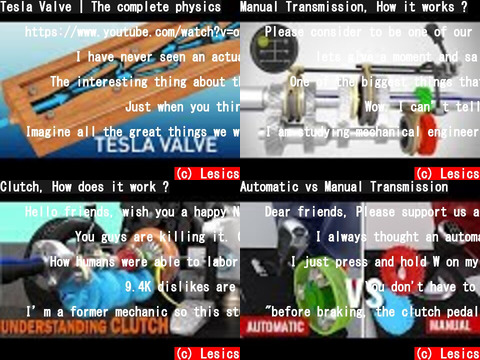













![岡田斗司夫 [切り抜き] 編集ちゃんねる(Youtube 動画 pick up)](https://imitoha.com/c/imgc/UCwfyW7i8kAFUj8_tSSDT_PA/-a-input.jpg)









コメント